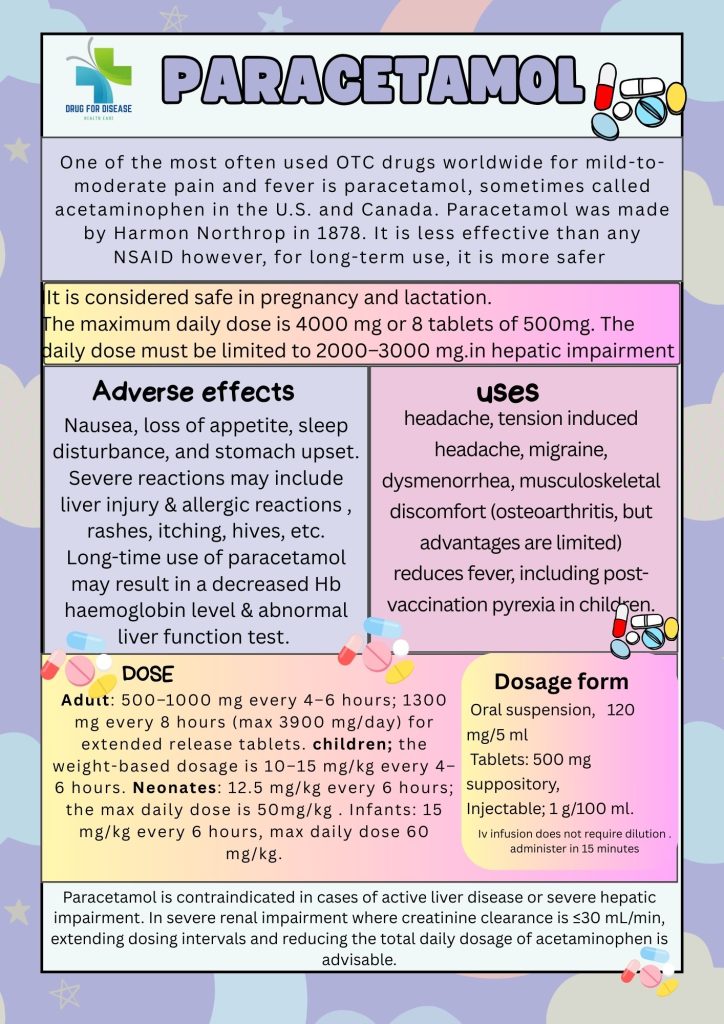Paracetamol
One of the most often used over-the-counter (OTC) drugs worldwide for mild-to-moderate pain and fever is paracetamol, sometimes called acetaminophen in the U.S. and Canada. Created in the 19th century, it has become a first-line treatment because of its effectiveness and tolerability. Improper use, meanwhile, can cause major liver damage or deadly overdose. This paper discusses its applications, dosage forms, dosing recommendations, and contraindications.
Uses in Medicine
Analgesic properties;
Paracetamol works for relief of pain like
These include tension-type headaches and migraines.
Musculoskeletal discomfort (e.g., osteoarthritis, but advantages are limited)
Often taken with opioids or NSAIDs for greater impact.
Post-surgical or dental pain
Dysmenorrhea
Cold- or flu-related pain, mostly used & available in combination form
Antipyretic
It reduces fever in adults and children, including post-vaccination pyrexia.
For long-term fever management in children, though, it is less successful than ibuprofen. Still, for long-term fever management in kids, it is less successful than ibuprofen.

Dosage Forms & Dose
To fit various age ranges and medical requirements, paracetamol comes in several formulations
Oral Preparations
Tablets/Capsules: Immediate-release (325–500 mg) and extended-release (650 mg)
For pediatric use, liquid suspensions/syrups (e.g., 120 mg/5 mL or 250 mg/5 mL)
Effervescent Tablets/Powders 500-650 mg, dissolved in water
Chewable/Orally Disintegrating Tablets.
Intravenous infusion of 100 ml or 2 ml ampoules. Infusion is available in a 10 mg/mL solution injected over 15 minutes to reduce fever.
Suppositories are used when oral administration is impractical (e.g., 60–1000 mg)
Dose recommendations are as follows:
Adult Dose: 500–1000 mg every 4–6 hours; the maximum daily dose is 4000 mg or 8 tablets of 500mg.
Extended Release: 1300 mg every 8 hours (max 3900 mg/day)
For children, the weight-based dosage is 10–15 mg/kg every 4–6 hours.
Age-specific dosages of paracetamol include 60 mg for neonates aged 2–3 months (maximum of 2 doses per day after immunisation) and 240–500 mg for children aged 6–12 years (maximum of 4 doses per day).
Syrups or liquid preparations need accurate measurement using provided syringes or spoons.
Special care is required in hepatic impairment. The daily dose must be limited to 2000–3000 mg.
In pregnancy, it is considered safe at recommended doses; use the lowest effective dose for the shortest duration.
In elderly people, due to comorbidities, doses need to be reduced.
Contraindications and Precautions
Absolute Contraindications
Severe hepatic impairment or active liver disease.
Hypersensitivity to paracetamol.
Relative Contraindications
Alcoholism: Increases risk of hepatotoxicity; max 3000 mg/day
Malnutrition or Dehydration: Low glutathione reserves heighten toxicity risk
Renal Impairment: Dose adjustments required (e.g., extended intervals for CrCl <30 mL/min)
Drug Interactions
Warfarin: Prolonged use may increase INR and bleeding risk
Enzyme Inducers (e.g., carbamazepine): Accelerate metabolism, increasing toxic metabolite (NAPQI) production
Overdose and Toxicity
Exceeding 4000 mg/day (or 75 mg/kg in children) risks acute liver failure, characterised by nausea, vomiting, jaundice, and elevated transaminases.
Treatment: Administer N-acetylcysteine (NAC) within 8–24 hours of overdose to replenish glutathione
Last Words
Its safety record when taken properly makes paracetamol a mainstay in the treatment of pain and fever. Preventing toxicity depends on following dose restrictions and knowing contraindications. Patients should refrain from using several acetaminophen-containing drugs and speak with doctors about long-term use or comorbidities.
